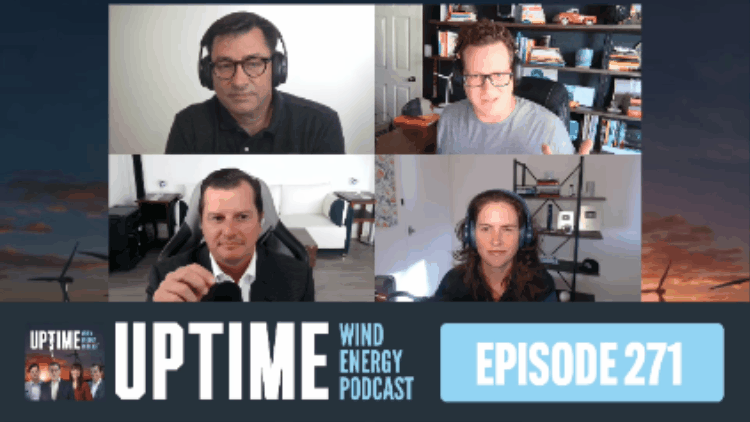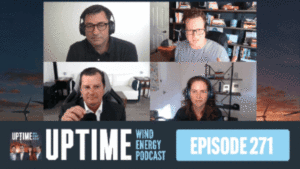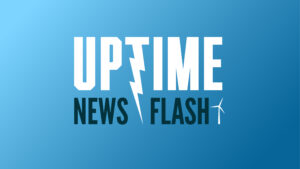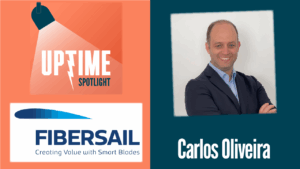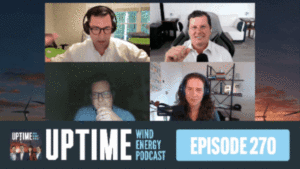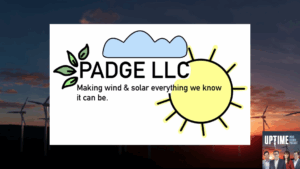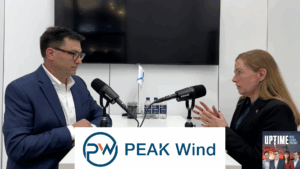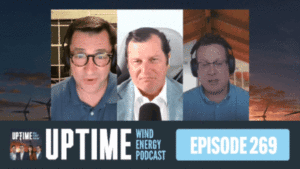Podcast: Play in new window | Download
The hosts discuss the recent $62 million funding round for Aerones, Siemens Energy’s call for increased offshore wind capacity in the UK, Canada’s push for offshore wind with Bill C-49, and the installation of Vestas’ 7.2 MW turbine in Germany. And the Coyote Wind Farm in Texas as the Wind Farm of the Week.
Sign up now for Uptime Tech News, our weekly email update on all things wind technology. This episode is sponsored by Weather Guard Lightning Tech. Learn more about Weather Guard’s StrikeTape Wind Turbine LPS retrofit. Follow the show on Facebook, YouTube, Twitter, Linkedin and visit Weather Guard on the web. And subscribe to Rosemary Barnes’ YouTube channel here. Have a question we can answer on the show? Email us!
You are listening to the Uptime Wind Energy Podcast brought to you by build turbines.com. Learn, train, and be a part of the Clean Energy Revolution. Visit build turbines.com today. Now here’s your hosts, Alan Hall, Joel Saxon, Phil Totaro, and Rosemary Barnes.
Allen Hall: And welcome back to the Uptown Wind Energy Podcast.
I’m here with Rosemary Barnes, Joel Saxon, and Phil Ro. Uh, crazy week. Again, I don’t know how else to describe it. The, I was just telling our producer this morning that there’s so much news coming out where it seemed like to be a little bit of a lull after the US House bill, but it’s picked right back up again.
And one of the more exciting things that’s happened is A owns closed a $62 million series B. Uh, led by Activate Capital and S two G with, uh, revenue growing at Aeros by about 300% in 2024, and they are getting a lot of requests from [00:01:00] operators in the United States and elsewhere to fix their wind turbine blades.
They have been working pretty closely with GE Renova and NextEra. Over the last, what Joel say two years, maybe a little bit longer on a number of problems.
Joel Saxum: Yeah. A couple years they’ve been doing, uh, bespoke solutions for both of them. They’ve also been doing their, you know, standard things that they’re rolling out to the rest of the market.
But I think this is a good thing. In one article that I was reading, there is like a tier one operator starting to adopt it, right? So. Everybody was kind of approaching that robotic thing, like, yeah, it looks like it’s the future and, you know, but a little trepid, right? Dipping a toe in or dipping a finger into the water, trying it out.
But now it seems like, hey, we got an LEP campaign, coones, we’ve got this robotics problem we wanna solve, collar owns. So they’re starting to get more and more adoption and, and that shows, right, 300%, uh, revenue growth in 2024. So that’s, that’s huge, right? To, to hit that kind of number. So now it’s up to, uh, scaling up.
Uh, the only thing that can cap that number is the amount of robots that they can put outta the [00:02:00] factory over there in Riga.
Allen Hall: And we visited their facility in the United States about a year ago. It was just outside of Dallas, near Lake Dallas of all places. And it is a decent sized facility, but at the time we, when we walked around out back, you just noticed a whole bunch of, uh, parking lot spaces with trailers and capabilities for robots and thought, wow, that there’s a lot of robot, uh, sitting in the parking lot.
And, uh. But then they had, when I asked they, they said, oh, they had a ton of crews already out in the field working. So they do have the ability to get to a number of turbine sites. I, I guess maybe still not enough from what I hear, there’s, the demand has gone through the roof.
Joel Saxum: Well, it’s, it’s a really interesting, or really cool, I guess, opportunity for technicians.
So that’s one of the things that robotics does is it addresses the technician shortage. You got a technician shortage, great, let’s use robots. Then we can start, uh, having that force multiplier, right? Because you could run robots on two turbines from one control van. You can do a lot of stuff there. But as a technician, [00:03:00] what a great opportunity.
If you know blades, if you know in the field, you don’t even have to know that stuff. Not even go work with robotics and AI and like the future of cool things. And I know that a Rowan’s part of their growth and their plans here, they got the $62 million. Of course, we don’t know all the plans they are gonna do with that, but I do know that they’re making a push to hire locally to get local talent, to get local back office to expand their presence in the states.
’cause it’s a, it’s a, it’s a huge market here, right? So they’ve brought on some, some more, uh, horsepower locally from the states, whereas before they were having to bring a lot of technicians over from, from Europe. They’ve started to crack into that and use more local stuff to be able to do things faster and more efficiently, which is, uh, you know, that’s better for all the, all their customers as well.
Allen Hall: Well, I think one key about this announcement is when opportunity presented itself, I. Rowans went after it. And that opportunity was with GE Renova on some tip mast additions. And there was a lot of [00:04:00] blaze that needed some more weight in the tip, and the robot could do it faster. I think at the time, uh, GE was planning on doing it with technicians on ropes, and then, uh, aeros demonstrated they could do it faster, more consistently with robotics, and that was the opening that they needed.
I don’t remember how many, uh, blades they have done that, uh, addition to, but it’s gotta be in the thousands at this point.
Joel Saxum: I’d say this about that Arons team. I mean, you, you and I know Dyna crews very well, the CEO, we know the CTO, we know the sales team. Some of the operations people, they are not shy on grabbing an opportunity and running with it.
And, and I’ll also, this the, one of the, one of, in the, in the wind industry, one of the best companies I’ve seen. Run with primary market research, right? Where someone says, here’s a problem, can you help us solve it? Boom. They’re on it, creating a solution tomorrow. Um, and not a lot of people do that very well.
So [00:05:00] I think that’s been part of their, their prowess in, in the scale that they’ve done. And what of course, and oversubscribed funding round means you’re doing something right. And I, and I think that that shows.
Allen Hall: Over in the uk, Siemens Energy’s UK Vice President warns that allocation round seven, which is upcoming, must award a record six gigawatts of offshore wind capacity to maintain the trajectory towards the 43 to 50 gigawatt goal by 2030.
Target that the UK has set up for itself and there are, the UK is at about 15 gigawatts at the minute, and. So the, the push from Siemens is we have a factory in haul. We make blades and make turbines. We we’re really good in offshore work, but we really need to go. Uh, and that’s driven by governments putting out, uh, awards and driving the industry forward.
And, and Siemens UK vice president is saying, now’s the time. Now is a time that they really need to show progress. I think that’s [00:06:00] generally true. If you do look at, and if you, Joel, I don’t know if you saw this, or maybe Phil, you saw this this week. Uh, the UK put out a map of where all the wind farms are and where all the permanent or the rare earth magnets were located and when those farms are gonna come offline in an effort to potentially recycle those rare earth magnets.
So you have this nice little. A year by year map of the decommissioning of one cype decommission when they could reuse those rare earth magnets. And you can see all the wind farms in the uk. There are a lot of wind farms right now in, mostly on the west coast. Well, some of the west coast, a decent amount on the East coast, but there’s still a lot of onshore wind, which I didn’t realize, uh, that.
UK government effort is really paying dividends, I think, but the rate’s not enough. I guess that’s the problem. The rate is not enough to keep up where their goals are. Phil is, are they gonna be able to do that even if they [00:07:00]do have a, an allocation round of, you know, upwards of six, seven gigawatts coming up.
Phil Totaro: That’s the challenge. They have about, uh, 11,000 onshore turbines, um, in the UK at this point, according to, to our data, uh, and offshore, I forget what the turbine count is, but it, they’re, they’re up there in the, you know, 28 to 30 gigawatts now, um, that’s operational or under construction, um, which is fantastic.
You know what Siemens is saying is that. Based upon what’s happened in previous allocation rounds, um, specifically they didn’t have enough capacity to serve the entire demand. Um, basically what they were willing to allocate at, at a particular price point. Uh, and so it left the project developers and independent power producers is left with, well either, you know, we’ve gotta go find a corporate power offtake, which really for uh, [00:08:00] an offshore wind farm is gonna be much.
More challenging to do, uh, than, than onshore because of the, the size and scale of these things. Of course. Um, so, you know, they are still largely dependent on the government, you know, facilitating this offtake through, you know, national Grid and, and the other grid operators to be able to have. That allocation of power and then, you know, more utility contracts get signed, um, that way.
And, and that’s how people get fed. How
Joel Saxum: many years, Phil, did they have that? Uh, like on there was an onshore moratorium against more new onshore wind. How many years did that last?
Phil Totaro: I wanna say it was like eight. Uh, if memory serves to, just to clarify this, so the head of moratorium in Lower England, which is basically, you know, not Wales, not Scotland, not Northern Ireland or, uh, you know, any of the outer banks areas.
Um, but just lower [00:09:00] England, they’ve removed that. At least in principle. And so far there’s only been one proposed project from Kubico, uh, that was actually had been proposed from like, whatever, 15, 20 years ago. And now they’re like, Hey, great, we can actually do our project now. Uh, you know, like everybody’s just kind of waiting for whatever the mechanism is gonna be.
Um, and where the demand is is gonna come from the, you know, everybody keeps talking about things like AI and data centers and. Et cetera. And, and yet their, their pipeline for project proposals in, uh, you know, the lower England, again, so to speak, is, is, uh, a little bit thin by comparison. They’re really trying to focus more on offshore wind for.
You know, power that’s gonna be fed into London and the surrounding areas. And Scotland is still going strong with, uh, you know, with onshore wind and of course whatever, whatever offshore they’ve got up there. Um, [00:10:00] but they’re building a lot of interconnectors as well with Ireland, with France, um, and I think one with Norway, if memory serves or is it Denmark?
One of those. Um, but they’re, they’ve got, you know, power links going all over the place now to be able to, to, you know, feed and balance power with Europe.
Joel Saxum: Yeah, I think the, I think the interesting thing here is, um, I mean, from Siemens energy point of view and from, I mean, you name it, if it’s Vestas or GE or whoever of their offshore wind needs some wins.
Uh, no pun, no pun intended. Like, we, we need some good news. We need one of these auctions to go well as a, as a group. Um, just to reinstall confidence that offshore wind is the, the way of the future, right? So we have some movements, right? You’ve seen Japan open up their EEZ, that’s fantastic. Um, we saw some of the projects in the states get moving again, great news.
Um, but you see still this kind of lukewarm temperature towards offshore wind. So it would be great to [00:11:00] see this thing go fantastically so that, uh, we get. Kind of the, the winds back in our sails pushing
Allen Hall: offshore wind forward. We’re gonna take a quick break here, but when we come back, we’re gonna talk about Canada getting into offshore wind and what that means as wind energy professionals staying informed is crucial.
And let’s face it difficult. I. That’s why the Uptime podcast recommends PES Wind Magazine. PES Wind offers a diverse range of in-depth articles and expert insights that dive into the most pressing issues facing our energy future. Whether you’re an industry veteran or new to wind, PES Wind has the high quality content you need.
Don’t miss out. Visit p ps win.com today. Well, up in Canada, Canada’s uh, bill. 49 C 49, uh, establishes a joint federal provincial management of offshore renewable energy development with Newfoundland and Labrador, uh, targeting up to $1 trillion in renewable energy investment by [00:12:00] 2041. Trillion’s a big number, Joel.
Uh, the, the regulatory framework addresses jurisdictional complexities that have historically complicated offshore development and is creating some streamlined programing. Permitting that, uh, mirror successful offshore, uh, petroleum models. Now, I, this is really Canada taking advantage of what has happened off the east coast of the United States in that, uh, if progress is gonna slow off the Atlantic, then Massachusetts, New York, New Hampshire, Maine, all those East coast states can be fed and are currently fed.
Um, by Hydro Quebec and others, uh, to provide power. So if they, if Canada does decide to build offshore wind up in Newfoundland, it’s pretty easy to get the power to Canada and to the United States. That could be a huge win. And the cost of doing business in Canada is lower than it is in the United States at the moment.
Joel Saxum: There’s a fundamental trouble there. So, Newfoundland Labrador, [00:13:00] amazing wind resources, like I’ve spent some time up there, right. Um. The other side of it is, uh, about 90, I think it’s like, it’s really high. It’s like 98% of their power is renewable already. It’s, they have a lot of hydro, they have a ton of hydro resources and a lack of, uh, heavy industry or load.
Right. So it’s not, if you look at the population of Newfoundland, like most of it’s in St. John’s Labrador. Labrador City Lab City’s got some population, but the population of those two areas, and I I, the island of Newfoundland and Labrador mainland is so small that there’s not that much demand. Right. I think they’re total, I can’t even say what their total numbers are, but I know they’re low.
Right. And there’s not a lot of heavy industry there. There’s not a lot of things there that are going to take advantage of this wind resource they have. So you’re either gonna be looking at green hydrogen of some sort. Or you’re gonna be exporting. So whether you’re exporting back to the [00:14:00] mainland or you’re HVDC exporting down to the states, and that’s the route I would go simply because even when you start passing back to the mainland, so you’re gonna New Brunswick and that, like, there’s no load there either.
Like there’s no load until you hit Halifax. Right? So there’s, there’s just a lack of, there’s there, they have the abundance of wind resource and a lack of off take. So. Put it in a cable and ship it down to the states where we need it anyways. And, uh, triage it that way, that’s the way I would look at it.
I’m, I’m super happy up for, for them.
Rosemary Barnes: But Quebec’s already connected to the US right? They’re, yeah. So if they are, their grids already very renewable, but it’s hydro, which is dispatchable. And so if they can replace more of their own, um, you know, local generation, even if they can’t connect all of that, um, you know, new, the new projects, if they can’t get capacity to connect it all to the us you know, directly, they could at least reduce the amount of their hydro that they have to use [00:15:00] themselves and then allow them to sell it to the US when, um, yeah, when prices are high.
So it seems like it would still be, still be a win. And it also seems like it would be a whole lot easier to develop those wind farms than to go slightly south and you know, the troubles that the US is having developing. Developing those regions for offshore wind seems like this would be an easier solution.
I don’t see a whole lot of like the, you know, the northeast of the us. So many people live there and they just seem like really set on categorically eliminating every single, um, sensible idea that they could have for. Generating electricity into the future and not just assuming that they want to decarbonize, even forgetting about that, they’re still, like, they, they won’t, they, they won’t build anything basically.
Every, you know, you can’t, um, take advantage of the inland wind. They don’t want more nuclear. They don’t want more gas. They don’t want, uh, yeah, the, the, they don’t want offshore wind. [00:16:00] I, I don’t know. There’s, there’s a finite number of options that you can. That you can choose from to, um, figure out your new, you know, what your future electricity mix is gonna be.
Um, it seems like it might be easier to, uh, you know, build a project in Canada, but they don’t seem so, so, uh, you know, bothered by every single option that you could come up with to generate electricity. They seem quite happy to, you know, generate cheap green energy and, um, sell it at a premium to the us so.
Maybe that’s a, a win-win for everybody. I mean, it’s a, it’s a win-win except for in probably the, the cost of electricity that, um, you’ll pay in, in New York, obviously it would be cheaper to just directly build the offshore wind and connect it right into the grid there, rather than having to go across the border via HVDC, but
Allen Hall: I don’t know.
I, I, yeah, I’m really wondering about the economics of that Rosemary. Just because things are cheaper in Canada. Well, yeah, it was about 30% less than what it costs in America to do things. [00:17:00] So just during that 30% number, if you could install wind at a 30% lower cost, you could then spend some money on building a cable or two.
To me, that’s, that would, it would start to pencil out. You have to start thinking. America’s not gonna move. They’re
Joel Saxum: attached to Canada permanently. One, one of the things that we’ve said that there’s an issue with the United States, okay, we talked Jones Act and Vessels and these kind of things, but one of the, you know, the crux of the Jones Act is people and the fact that along that, like East Coast of the United States, while it is a maritime or a marine environment, it is not a maritime society, right?
You don’t hit. A lot of big ocean going like, like when you’re in Denmark, a lot of people have worked on boats. They’ve worked offshore, they’ve done these things. You don’t run into that along the East Coast of the United States. However, when you go to PEI and Cape Breton and Nova Scotia and Newfoundland, PE, like those people, they’ve.
They’ve lived with the [00:18:00] ocean, right? That’s, that’s their bread and butter. They’ve been on fishing boats. They know there’s a lot of mariners up there. So I think that if you’re looking for the ability to ramp up and scale up a, uh, a workforce, it might be easier to do it there as well. So there’s some advantages to doing things in Canada.
Allen Hall: Do you think that, uh, they’ll find. Operators willing to take that risk or who have put down deposits on turbines that they can’t put into the United States that’ll just say, Hey, we can move up to Canada and do it there.
Joel Saxum: Well, I think there’s, there’s a couple of trouble troubling things there. If you wanna operate in Newfoundland Labrador, offshore wind, you better have your wits about you when it comes to o and m, ’cause that is an unforgiving environment.
I mean, you’re literally, you’re combating, uh, icebergs, right? The Titanic sunk off the coast of Newfoundland. So just so we’re all clear that their icebergs are a real thing up there. Really nasty. You’re in the North Atlantic now. You’re, you’re not in Kansas anymore, right? It’s, it’s [00:19:00] nasty up there. It ain’t Australia, I’ll tell you that.
So making sure that you, you’ve got your o and m budget squared away and everything is great. The other, the other economic thing. I don’t know what kind of, now they’ve said they’ve streamlined some permitting and some other things here in this bill that Canada put up. Great. To export renewable energy from Canada to Mexico or to Mexico, from Canada to the United States.
You got, you got to have your, the, the, uh, economics. Correct. Because one of the things we always talk about in the o and m world is how much better the PPAs are in Canada. Right where you’re gonna see, you’re gonna see in Michigan a 60, $70 PPA, you go across the border in Canada and that is a a hundred dollars PPA or $110 PPA.
Right. So if you have a hundred, if you can, if you can build a, yeah, if you can build a wind farm, and, and I’m, I’m just looking at the map right now, I’m going clo a little bit closer. If you can build a wind, wind farm off shore in Nova Scotia, which is a couple hundred miles from Maine. Right. Not a big deal.[00:20:00]
You better hope that you can get more for that power coming into the United States than Nova Scotia would allow you in an offtake PPA agreement, because you’re gonna have to beat that to send it elsewhere.
Rosemary Barnes: But did you know that there’s a plan to connect the um, yeah, connect Canada? I, I think connect Labrador.
It might be from somewhere in that region anyway, to the, to the UK to. Island, maybe
Joel Saxum: that, I mean, that makes sense.
Rosemary Barnes: Yeah. I mean it’s long, I think it’s four or 5,000 kilometers, um, cable, something like that. Um, may maybe it goes ahead. Maybe it doesn’t. It, yeah. It, it’s long, it’s unprecedented. There’s a whole lot of technical challenges to solve, and I.
But you know, like as far as some of these, uh, really big interconnections, I mean, there’s always a political challenge that, you know, I just mentioned between, um, Canada and the US Probably wasn’t the slam dunk that you would’ve thought it was a couple of months ago. But some of the other big ones that are planned, like from Australia, they plan to connect the north of Australia to Singapore via Indonesia.
I mean, we’re not countries that are, you know, extremely, uh, close [00:21:00]on our, um, you know, international relations. Then the other big one is X links between Morocco and the uk. And again, like these aren’t countries that we’re not like at war or anything, or worried about imminent war. I mean, we’re, we’re friendly but not extremely like-minded.
You know, between, um, Ireland and, uh, and Canada. I mean, that’s, as you know, that, that’s more closely aligned in terms of, you know, culture and, uh, history than any of those other pairings. So I do think it has that benefit.
Phil Totaro: The challenge with this is that we actually ended up canceling a lot of the grant money for some of those HVDC lines we were gonna put.
To expand the capacity between the US and Quebec. Uh, so they’re gonna build, you know, additional pipeline there to be able to, to offtake some of that power. But we’re not gonna be able to accept it if we don’t have the matching HBDC [00:22:00] capacity to be able to offtake the power down here. So that’s still a technical challenge to be overcome potentially in another three and a half years.
Allen Hall: When we come back from the break, we’ll talk about vest’s newest. Onshore turbine, a masses 7.2 megawatt machine. Don’t let blade damage catch you off guard. OGs. Ping sensors detect issues before they become expensive, time consuming problems from ice buildup and lightning strikes to pitch misalignment and internal blade cracks.
OGs Ping has you covered. Their cutting edge sensors are easy to install, giving you the power to stop damage before it’s too late. Visit eLog ping.com and take control of your turbine’s health today. Well, Vestas has achieved its first commercial installation of its V 1 72, 7 0.2 megawatt turbine in Germany.
Joel, this is awesome. Which marks the latest evolution of, uh, the Inventus platform. They’re looking towards medium and low wind sites, [00:23:00]which I think makes a ton of sense.
But they’re also, uh, I think the hub height’s like 175 meters because they’re having issues in Europe. Right, right. It’s 175 meters. Uh, but the rotor, Joel is 172. Right. So. The rotor diameter and the hub height, you know, it’s, it’s, they’re approaching one another. Uh, 7.2 would be a big term in the United States.
GE is only offering what a 6.1 at the moment is kind of where they stopped. This one makes sense
Joel Saxum: that they’re putting it in Germany though, because Germany classically, right, they’re a little bit more land constrained for turbine locations, right. It’s not like the United States where you drive across Iowa and you’re just like, boom, boom.
There’s a hundred turbines there and a hundred turbines there. Um, they’ve gotta pay a little bit more attention to, they’ve got a lot of little smaller towns in places and different local laws. Uh, so you’d see smaller, I imp smaller wind farms. And I think what you’ll start to see here is, is [00:24:00] as those wind farms have that interconnect and they’re good to go, but they’re getting aged out, you’ll see one of these turbines replace, you know, 2, 3, 4 of the old ones.
Uh, is, is what I could see in some of those European. Places as well.
Allen Hall: Is there a broader market for a seven megawatt machine? I think so. Um, I guess I’m asking is there’s a lot of low wind areas that tends to be what’s left. All the prime locations with medium high wind are already taking. So if you want to hit somewhere and put a lot of turbines up, you have to be low to medium.
Speed is, it’s a question of the hub height. The 175 meter hub height is. Big.
Phil Totaro: Yeah. And the, the challenge with that is that, uh, I think Rosie mentioned it last week or two weeks ago, about when people build wind farms, they interconnect them to the closest, uh, available transmission. Certainly, you know, that’s what they’ve done in Australia.
That’s what we did in the United States as well. Um, and. [00:25:00] You’re necessarily going to build out everything you can in what we used to call kind of IEC class one winds. That’s the highest, you know, average wind speed about 10 meters a second. Once you’ve kind of fully penetrated those sites that are in close proximity to transmission, you start stepping down, you know, your average wind speed, and then that’s why you need to increase the, the power density.
And basically for a given, you know, nameplate capacity of the turbine, you’re, you’re making a bigger and bigger rotor all the time and a higher and higher hub height. Um, so where is the market for this besides, you know, Scandinavia and Germany and a few places in eastern Europe? Australia is the big market.
Chile, Argentina. If Brazil decides to come back as a market, that will be a market for these as well. Um, it’s basically places where they still have wide open country and they’re not gonna be land constrained. Now, theoretically, in the United States, we’re not land constrained, but. We, uh, you know, you’re only gonna [00:26:00] be able to put these in specific places where you don’t have FAA interference or, you know, you, a lot of counties and townships now have, you know, tip clearances from, you know, adjacent dwellings that are gonna preclude you from using anything this big in this market.
It’s one of the challenges that a company like Weg, who also has a seven megawatt turbine, they’re trying to sell it in the United States and, you know, it hasn’t been, unfortunately for them going. Uh, very fast because there’s only a handful of sites where they can kind of put that thing and, and repower those, um, you know, these type of smaller projects with something this, you know, this massive.
Rosemary Barnes: Yeah. And I think that equation is changing a bit recently. Like, um, like you said, you know, you start out in high wind speed sites that are near transmission and then kind of go down. I think what counts as near transmission is sort of. Changing because it’s harder. I think everybody around the world is finding it hard to build out even small bits of new transmission that they [00:27:00] need now compared to what we thought that it would be like a few years ago.
So I know in Australia our grid operator is explicitly, um, trying to move away from having to rely on that. So that means, yeah, building out more renewables in or close to urban areas. And, um, yeah, part of that, especially for wind, is gonna mean accepting a, a lower quality resource, which is, you know, the cost of energy from the, a lower, a lower speed wind site is gonna be higher than an equivalent, you know, higher speed one.
Um, Australia is definitely, like, when I talk to developers, onshore developers, they definitely are largely thinking bigger, bigger, bigger turbines for onshore still. So there’s an appetite for it. Um, I do question, you know, to what extent it makes sense.
Allen Hall: And the question I always have is, how many turbines do you have to sell early on to make the project profitable?
Rosemary Barnes: Oh, I don’t think the early sales are [00:28:00] gonna make it profitable or not, but, um, definitely most of the. OEMs like to have a large initial customer or a few before they start developing something.
Something that’s quite new. Unless they’re, you know, like really certain that it’s gonna be their new workhorse platform. Um, you know, if it’s a bit niche, they definitely want some, um, advanced sales to cover the cost of development. At the very least.
Joel Saxum: I think, I think Phil, one time, a long time ago you said it would be roughly cost like a billion dollars when you go from a brand new turbine model.
Now this is Inventus platform, so this platform has been done before.
Phil Totaro: That was for offshore. We, we have run numbers in the past on, um, exactly this kind of profitability question, like how many units do you have to produce of each make and model for the OEMs, which is actually why when, when Siemens Gmaa merged, their numbers looked so.
Weird that we were like, this can’t be true. But it’s exactly predicted [00:29:00]why they ran into the profitability problems that they did even prior to trying to sell the, the four megawatt platform. Um, we kind of held back from publicly announcing that because we thought we were wrong and I should have, you know, insisted that we do it because it, it would’ve really shed a lot of light on, on what was really going on over there.
But anyway, in the meantime, it’s, it’s roughly for like a. Two to 2.53 megawatt turbine. It was about 350 units as you go scale up nameplate capacity, it starts coming down. Um. You know, in, in the number of units you need to sell, but it’s still roughly around, um, let’s say, you know, six to 800 megawatts worth of capacity needs to be sold just to break even.
Um, and that’s assuming, ’cause again, back in the day when we did the calculation, they were still having like a 12% margin. They’re not getting that anymore. It’s maybe like two to 5% now. So let’s say conservatively, it’s probably [00:30:00] about 1.2 gigawatts worth of capacity needs to be sold for them to just.
Break even. And, uh, you need, you know, really to turn a, a serious profit to get, you know, executives interested. Probably about two gigawatts worth of sales. So this week’s Wind Farm of the Week is
Joel Saxum: the Coyote Wind Farm. This is an EDF Wind Farm in Scurry County, Texas. So it’s 243 megawatts. And we’re, we’re switching gears and gonna talk about the SGRE.
4.5 megawatt, 1 45 turbine. On this one there’s 59 turbines. So they’re big turbines, right? Big turbines in the United States. More power with less footprint. An interesting thing here is, uh, at the time this thing was put in, that was some of the first, uh, installations of the SGRE 1 45. Uh, in the states and Masar, uh, owns 50% of this thing with, uh, EDF.
So you have 50% EDF, 50% masar. EDF runs the wind farm of course, for them. Uh, but Masar money coming from overseas, coming from the Middle East. Um, so, and that was [00:31:00] one of their first to four raise into the United States as well. Um, this wind farm can generate, uh, enough power to sufficiently supply about 65,000 households, which is really interesting.
Uh, and again, we always wanna focus on community engagement. Here we’re talking Wind Farm of the Week. Uh, what they did when they built this wind farm, uh, was to make sure that they engage with the local stakeholders they had meeting after meeting, after meeting edfs and the team out there, uh, talking with the locals, and they got, uh, everybody to buy into this one locally.
And there’s a really cool, and what I wanna focus on here is there’s a really cool, uh, YouTube video. So if you’re on YouTube, uh, spending some time at work or, or at home. Uh, just look at the Coyote Wind Project, uh, from EDF and they have a video there about how they showcase this thing locally, uh, and how they work with the local government.
So the Wind Farm of the week this week is the Coyote Wind Farm from EDF.
Allen Hall: Thanks for that Joel and Rosemary, Phil and Joel and I, we’ll be back next week from the Uptime Wind Energy Podcast. [00:32:00] Everybody keep their heads up. There’s a lot happening in wind at the moment. Uh, it’s gonna change, it’s gonna get better.
We just need to focus on profitability. That’s what we really need to do right now. And I, I, I get everybody is frustrated and they should be, uh, but not everything’s locked in, in the United States. Things are headed. At least it smells like things gonna be headed in a little bit of a better space over the next couple of weeks.
So let’s see what happens and we’ll see you here. Next week on the Uptime Wind Energy Podcast.



